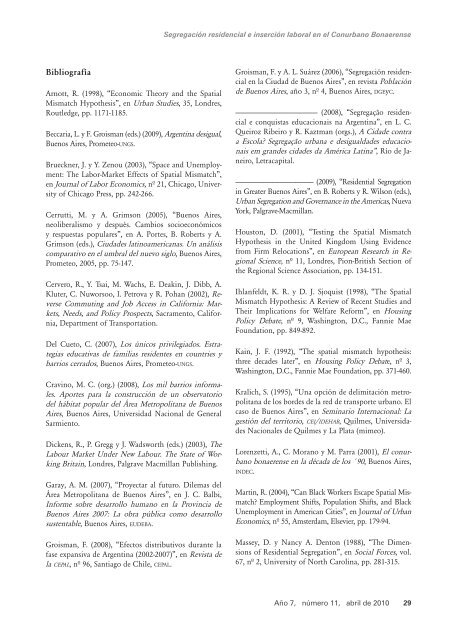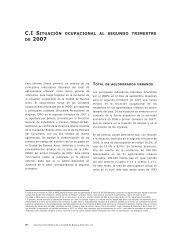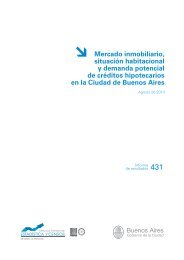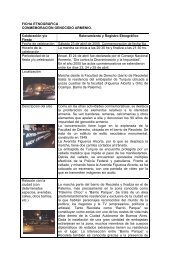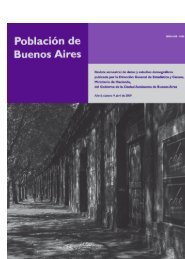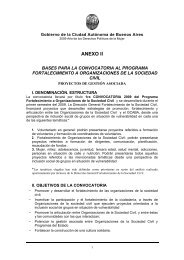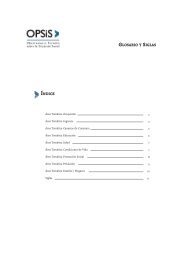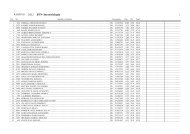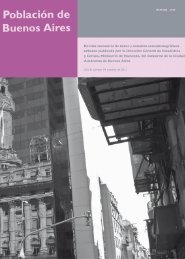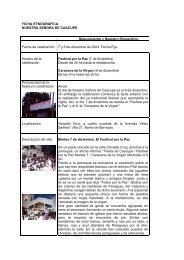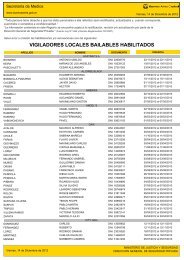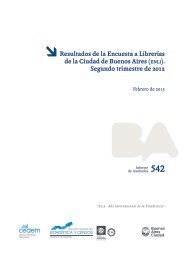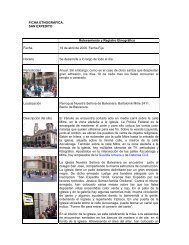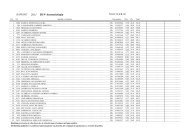Create successful ePaper yourself
Turn your PDF publications into a flip-book with our unique Google optimized e-Paper software.
Segregación residencial e inserción laboral en el Conurbano Bonaerense<br />
Bibliografía<br />
Arnott, R. (1998), “Economic Theory and the Spatial<br />
Mismatch Hypothesis”, en Urban Studies, 35, Londres,<br />
Routledge, pp. 1171-1185.<br />
Beccaria, L. y F. Groisman (eds.) (2009), Argentina desigual,<br />
<strong>Buenos</strong> <strong>Aires</strong>, Prometeo-u n g s.<br />
Brueckner, J. y Y. Zenou (2003), “Space and Unemployment:<br />
The Labor-Market Effects of Spatial Mismatch”,<br />
en Journal of Labor Economics, nª 21, Chicago, University<br />
of Chicago Press, pp. 242-266.<br />
Cerrutti, M. y A. Grimson (2005), “<strong>Buenos</strong> <strong>Aires</strong>,<br />
neoliberalismo y después. Cambios socioeconómicos<br />
y respuestas populares”, en A. Portes, B. Roberts y A.<br />
Grimson (eds.), <strong>Ciudad</strong>es latinoamericanas. Un análisis<br />
comparativo en el umbral del nuevo siglo, <strong>Buenos</strong> <strong>Aires</strong>,<br />
Prometeo, 2005, pp. 75-147.<br />
Cervero, R., Y. Tsai, M. Wachs, E. Deakin, J. Dibb, A.<br />
Kluter, C. Nuworsoo, I. Petrova y R. Pohan (2002), Reverse<br />
Commuting and Job Access in California: Markets,<br />
Needs, and Policy Prospects, Sacramento, California,<br />
Department of Transportation.<br />
Del Cueto, C. (2007), Los únicos privilegiados. Estrategias<br />
educativas de familias residentes en countries y<br />
barrios cerrados, <strong>Buenos</strong> <strong>Aires</strong>, Prometeo-u n g s.<br />
Cravino, M. C. (org.) (2008), Los mil barrios informales.<br />
Aportes para la construcción de un observatorio<br />
del hábitat popular del Área Metropolitana de <strong>Buenos</strong><br />
<strong>Aires</strong>, <strong>Buenos</strong> <strong>Aires</strong>, Universidad Nacional de General<br />
Sarmiento.<br />
Dickens, R., P. Gregg y J. Wadsworth (eds.) (2003), The<br />
Labour Market Under New Labour. The State of Working<br />
Britain, Londres, Palgrave Macmillan Publishing.<br />
Garay, A. M. (2007), “Proyectar al futuro. Dilemas del<br />
Área Metropolitana de <strong>Buenos</strong> <strong>Aires</strong>”, en J. C. Balbi,<br />
Informe sobre desarrollo humano en la Provincia de<br />
<strong>Buenos</strong> <strong>Aires</strong> 2007: La obra pública como desarrollo<br />
sustentable, <strong>Buenos</strong> <strong>Aires</strong>, eudeba.<br />
Groisman, F. (2008), “Efectos distributivos durante la<br />
fase expansiva de Argentina (2002-2007)”, en Revista de<br />
la c e pa l, nª 96, Santiago de Chile, c e pa l.<br />
Groisman, F. y A. L. Suárez (2006), “Segregación residencial<br />
en la <strong>Ciudad</strong> de <strong>Buenos</strong> <strong>Aires</strong>”, en revista Población<br />
de <strong>Buenos</strong> <strong>Aires</strong>, año 3, nª 4, <strong>Buenos</strong> <strong>Aires</strong>, d g eyc.<br />
————————————————— (2008), “Segregação residencial<br />
e conquistas educacionais na Argentina”, en L. C.<br />
Queiroz Ribeiro y R. Kaztman (orgs.), A Cidade contra<br />
a Escola? Segregação urbana e desigualdades educacionais<br />
em grandes cidades da América Latina”, Río de Janeiro,<br />
Letracapital.<br />
————————————————— (2009), “Residential Segregation<br />
in Greater <strong>Buenos</strong> <strong>Aires</strong>”, en B. Roberts y R. Wilson (eds.),<br />
Urban Segregation and Governance in the Americas, Nueva<br />
York, Palgrave-Macmillan.<br />
Houston, D. (2001), “Testing the Spatial Mismatch<br />
Hypothesis in the United Kingdom Using Evidence<br />
from Firm Relocations”, en European Research in Regional<br />
Science, nª 11, Londres, Pion-British Section of<br />
the Regional Science Association, pp. 134-151.<br />
Ihlanfeldt, K. R. y D. J. Sjoquist (1998), “The Spatial<br />
Mismatch Hypothesis: A Review of Recent Studies and<br />
Their Implications for Welfare Reform”, en Housing<br />
Policy Debate, nª 9, Washington, d.c., Fannie Mae<br />
Foundation, pp. 849-892.<br />
Kain, J. F. (1992), “The spatial mismatch hypothesis:<br />
three decades later”, en Housing Policy Debate, nª 3,<br />
Washington, d.c., Fannie Mae Foundation, pp. 371-460.<br />
Kralich, S. (1995), “Una opción de delimitación metropolitana<br />
de los bordes de la red de transporte urbano. El<br />
caso de <strong>Buenos</strong> <strong>Aires</strong>”, en Seminario Internacional: La<br />
gestión del territorio, c e i/i d e h a b, Quilmes, Universidades<br />
Nacionales de Quilmes y La Plata (mimeo).<br />
Lorenzetti, A., C. Morano y M. Parra (2001), El conurbano<br />
bonaerense en la década de los ´90, <strong>Buenos</strong> <strong>Aires</strong>,<br />
i n d e c.<br />
Martin, R. (2004), “Can Black Workers Escape Spatial Mismatch?<br />
Employment Shifts, Population Shifts, and Black<br />
Unemployment in American Cities”, en Journal of Urban<br />
Economics, nª 55, Amsterdam, Elsevier, pp. 179-94.<br />
Massey, D. y Nancy A. Denton (1988), “The Dimensions<br />
of Residential Segregation”, en Social Forces, vol.<br />
67, nª 2, University of North Carolina, pp. 281-315.<br />
Año 7, número 11, abril de 2010 29


